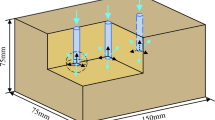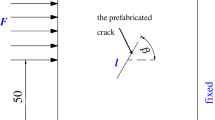Abstract
In order to investigate the effect of pore water pressure on the shear creep characteristics of structural plane, we have independently developed an integrated manufacturing die for structural plane and a multi-functional shear rheometer, meanwhile conducting shear creep of duplicated structural plane under osmotic pressure. The influence of pore water pressure on the shear creep seepage of a structural surface is analyzed. The test results show that a structural plane under different seepage water pressures has experienced an instantaneous-deformation stage, a decelerated-creep stage, a stable-creep stage, and an accelerated-creep stage. The increase of seepage water pressure promotes the development of nonlinear characteristics of the structural plane. In the stage of instantaneous deformation, the permeability of structural plane decreases to a certain extent compared with the initial permeability. In the stage of decay creep and stable creep, the permeability of the structural plane increases slowly and tends to be in a stable state. In the stage of accelerated creep, the permeability of the structural plane suddenly increases nonlinearly in a short time. Based on the nonlinear creep theory and fractional calculus theory, the viscous element of the creep model is replaced by a fractional viscous element, and a fractional nonlinear structural plane is established considering the effect of pore water pressure as well as stress damage. The model parameters are identified; meanwhile, the experimental curve is compared with the theoretical model curve to verify the correctness and applicability of the model. The research results provide some theoretical guidance for a long-term stability analysis of rock mass in water-rich areas.














Similar content being viewed by others
Data availability
All data, models, and codes generated or used during the study appear in the published article.
References
Cao P, Huang L, Yu C et al (2018) Nonlinear rheological model of rock considering the effects of joints. J Cent South Univ 49(02):401–406
Chen W-z, Sui Q, Wang L-y (2021) Development and application of a hydro-mechanical coupling shear creep testing machine for rock joints[J].Chinese Journal of Rock Mechanics and Engineering, 40(09):1729-1738
Deng H-l, Zhou H-w, Jia W-h et al (2022) A nonlinear triaxial damage creep model for granite based on atangana-baleanu fractional derivative. Int J Appl Mech 14(07):11–27
Ding X-l, Liu J, Liu X-z (2000) Experimental study of creep behaviors of hard structural plane in TGPs permanent lock regions. Journal of Yangtze River Scientific Research Institute 17(4):30–33
Hamiel Y, Lyakhovsky V, Agnon A (2005) Rock dilation nonlinear deformation and pore pressure change under shear. Earth Planet Sci Lett 237:577–589
He Z-L, Zhu Z-D, Li Z-J (2014) Study of nonlinear creep damage model of marble with structural plane. Sci Technol Eng 14(32):68–72
Jia C, Xu W, Wang R et al (2018) Experimental investigation on shear creep properties of undisturbed rock discontinuity in Baihetan hydropower station. Int J Rock Mech Min Sci 104:27–33
Jiang H-f, Liu D-y, Huang W et al (2014) Creep properties of rock under high confining pressure and different pore water pressures and a modified Nishihara model. Chin J Geotech Eng 36(03):443–451
Li Z-j, Zhu Z-d, Zhu M-l et al (2009) Study on shear creep and roughness effect on hard structural plane of marble. Chin J Rock Mech Eng 28(S1):2605–2611
Liu J-s, Jing H-w, Meng B et al (2020) A four-element fractional creep model of weakly cemented soft rock. Bull Eng Geol Env 79(10):5569–5584
Peng S-j, Tan H, Xu J et al (2017) Experimental study on shear mechanical properties of complete sandstone under different pore water pressures. Chin J Rock Mech Eng 36:3131–3139
Sun J, Li Y-s, Li X-s (1984) The rheological characteristics of tunnel opening in multi-set joint rock mass and its viscous elastoplastic effects[R].Shanghai:Tongji University
She C-x, Sun F-t (2013) Research on visco-elastro plastic rheological failure model of jointed mass. Chin J Rock Mech Eng 2:231–238
Shen M-r, Yang R-f (2018) Shear rheological characteristics and nonlinear constitutive model of serrate structure surface. Journal of Southwest Jiaotong University 53(05):1017–1025
Shen M-r, Zhang Q-z (2010) Experimental study of shear deformation characteristics of rock mass discontinuities. Chin J Rock Mech Eng 29(04):713–719
Tse R, Cruden DM (1979) Estimating joint roughnesscoefficients. Int J Rock Mech Min Sci Geomech Abstr 16(5):303–307
Xia C-c, Qian X, Gui Y et al (2018) A novel multi-functional shear-flow coupled test system for rock joints and its application. Chin J Rock Mech Eng 37(10):16–28
Xu P, Yang T-q, Zhou H-m (2004) Study of the creep characteristics and long-term stability of rock masses in the high slopes of the Three Gorges Ship Lock, China. Int J Rock Mech Min Sci 41(Supp.1):261–266
Xu T, Xu Q, Ranjith PG (2013) The evolution of rock failure with discontinuities due to shear creep. Acta Geotech 8(6):567–581
Xu W-y, Yang S-q (2005) Experiment and modeling investigation on shear rheological property of joint rock. Chin J Rock Mech Eng 24:5536–5542
Xiong L-x, Yang L-d (2009) Creep model for rock mass considering normal creep of rock joint plane. Journal of Central South University (Science and Technology) 40(3):814–821
Xiong L-x, Yu L-j, Yang C-b (2015) Shear rheological model for hard structural surface and test numerical analysis. Chin J Rock Mech Eng 34(S1):2894–2899
Yang S-Q, Hu B (2018) Creep and long-term permeability of a red sandstone subjected to cyclic loading after thermal treatments. Rock Mech Rock Eng 51(10):2981–3004
Yang S-q, Ni H-m (2012) A viscoelastic shear creep model of mudstone: parameter identification. J China Univ Min Technol 41(4):551–557
Yang S-l, Zhang J-m, Huang Q-p (2004) Analysis of creep model of jointed rock. Rock Soil Mech 25(8):1225–1228
Zhang L, Zhou H-w, Wang X-y et al (2021) A triaxial creep model for deep coal considering temperature effect based on fractional derivative. Acta Geotech 17(5):1739–1751
Funding
This work was supported by the National Natural Science Foundation of China (Nos. 52078093) and the Liao Ning Revitalization Talents Program (Nos. XLYC1905015).
Author information
Authors and Affiliations
Corresponding author
Ethics declarations
Conflict of interest
The authors declare no competing interests.
Additional information
Responsible Editor: Zeynal Abiddin Erguler
Rights and permissions
Springer Nature or its licensor (e.g. a society or other partner) holds exclusive rights to this article under a publishing agreement with the author(s) or other rightsholder(s); author self-archiving of the accepted manuscript version of this article is solely governed by the terms of such publishing agreement and applicable law.
About this article
Cite this article
Zhang, F., Jiang, A. & Jiang, H. Study on shear creep-seepage characteristics of structural plane under pore water pressure. Arab J Geosci 16, 406 (2023). https://doi.org/10.1007/s12517-023-11472-4
Received:
Accepted:
Published:
DOI: https://doi.org/10.1007/s12517-023-11472-4




